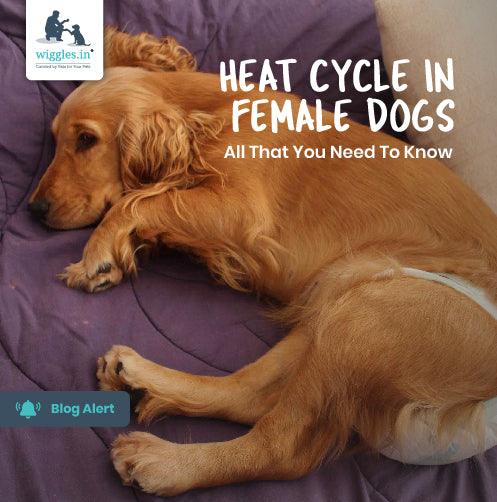Introducing the lovable and curious world of golden retrievers and their reproductive cycles! Have you ever wondered, “how often do golden retrievers get their period?” Well, let’s embark on this educational journey and discover the ins and outs of this fascinating topic.
Now, you may be thinking, what exactly is a golden retriever’s “period”? Don’t worry, we’ll clarify it for you. Consider this your guide to understanding the reproductive cycles of these adorable dogs. So, grab your furry companion and let’s dive in!
In this informative article, we’ll shed light on the frequency at which golden retrievers experience their reproductive cycles. We’ll explore the factors that influence these cycles, helping you better understand your beloved pet’s needs. So, get ready to enrich your knowledge and deepen the bond with your golden retriever!
Golden Retrievers are popular and beloved dogs known for their friendly demeanor and beautiful golden coats. But when it comes to their reproductive health, pet owners may have questions about their female Golden Retrievers’ menstrual cycle, also known as their heat cycle. In this article, we will explore the frequency and duration of the Golden Retriever’s heat cycle, as well as some helpful tips for managing it.
How Often Do Golden Retrievers Get Their Period?
Understanding the Heat Cycle
The heat cycle, also known as estrous cycle, is the reproductive cycle of female dogs. During this cycle, the female dog is receptive to a male’s advances and can become pregnant. The heat cycle typically occurs for dogs around the age of 6-12 months but may vary for individual dogs. It is important to note that the Golden Retriever’s heat cycle is different from that of humans.
The heat cycle consists of four stages: proestrus, estrus, diestrus, and anestrus. Proestrus is the initial stage, characterized by vaginal discharge and swelling of the vulva. The discharge can range in color from yellowish to reddish-brown. This stage usually lasts around 7-10 days. Next is estrus, the fertile period, where the female is most receptive to mating. The discharge turns lighter in color, and the vulva swelling subsides. This stage typically lasts around 4-9 days.
After estrus comes diestrus, a stage where the female dog is no longer receptive to males. This stage lasts around 56-58 days, regardless of pregnancy. Lastly, anestrus is the resting period, where the dog’s reproductive system takes a break. This stage can last for several months before the cycle begins again.
Frequency and Duration
The frequency and duration of a Golden Retriever’s heat cycle can vary between individuals. On average, Golden Retrievers experience their heat cycle twice a year, although some dogs may have irregular cycles. The heat cycle usually lasts for about 3-4 weeks, with each stage lasting for different durations.
It is essential to keep track of your Golden Retriever’s heat cycle to ensure proper care and management. During the proestrus and estrus stages, it is crucial to keep your dog away from intact males unless you are intentional about breeding. Additionally, you may want to use protective clothing or diapers to help manage any discharge during this time.
If you are unsure about the timing of your Golden Retriever’s heat cycle, consult with your veterinarian. They can provide guidance on monitoring the cycle and advise on appropriate care and safety precautions.
Managing Your Golden Retriever’s Heat Cycle
Managing your Golden Retriever’s heat cycle involves several steps to ensure the health and well-being of your dog. Here are some helpful tips:
- Monitor the cycle: Keep track of the start and end dates of each stage and note any irregularities to discuss with your veterinarian.
- Prevent unplanned pregnancies: During the proestrus and estrus stages, keep your female dog away from intact males unless you plan to breed them.
- Provide comfort: Your female dog may experience discomfort during her heat cycle. Provide a clean and comfortable space for her, and consider using protective clothing or diapers to manage any discharge.
- Keep up with hygiene: Regularly clean your dog’s genital area to prevent infections and keep her comfortable.
- Consider spaying: If you do not plan to breed your Golden Retriever, spaying her can prevent recurrent heat cycles and reduce the risk of certain health issues, such as mammary tumors.
Conclusion
Understanding a Golden Retriever’s heat cycle is essential for responsible pet ownership. By monitoring the cycle, managing your dog’s comfort, and taking necessary precautions, you can ensure a safe and healthy experience for your beloved pet. If you have any concerns or questions about your Golden Retriever’s heat cycle, consult with a veterinarian who can provide expert advice and guidance tailored to your dog’s specific needs.
Common Questions About Golden Retrievers’ Heat Cycles
1. Can I walk my Golden Retriever during her heat cycle?
While it is generally safe to walk your Golden Retriever during her heat cycle, it is crucial to keep her on a leash and away from other dogs, especially intact males. This precaution will prevent any unwanted advances and protect her from potential harm or unplanned pregnancies. Additionally, be mindful of her comfort and try to avoid strenuous exercise if she is not feeling her best.
2. How can I tell if my Golden Retriever is in heat?
There are several signs to look out for to determine if your Golden Retriever is in heat. These signs include swelling of the vulva, a change in behavior (such as increased friendliness or restlessness), frequent urination, and a bloody or straw-colored discharge. If you notice these symptoms, it is a strong indication that your dog is in heat.
3. Can my Golden Retriever get pregnant if she is spayed?
If your Golden Retriever has been spayed, it means her reproductive organs have been surgically removed, and she can no longer get pregnant. Spaying is an effective method of preventing unwanted pregnancies and offers several health benefits for your dog, such as a reduced risk of certain cancers and infections.
Key Takeaways: How Often Do Golden Retrievers Get Their Period?
- Female golden retrievers typically go into heat or have a period twice a year.
- Each heat cycle usually lasts for about 2-3 weeks.
- It is important to keep male dogs away from females in heat unless breeding is intended.
- During their period, female golden retrievers may experience behavior changes or become more affectionate.
- Proper care and hygiene should be maintained during this time, such as using diapers or keeping the dog indoors to prevent unwanted pregnancies.
Frequently Asked Questions
Welcome to our FAQ section where we answer common questions about golden retrievers and their reproductive cycles.
How often do female golden retrievers go into heat?
Female golden retrievers typically go into heat, or have their period, approximately every six to eight months. However, the frequency can vary from dog to dog. It is essential to monitor your dog closely for signs of heat, such as swelling of the vulva and changes in behavior, to determine when she is ready to breed or should be kept away from intact males. Discharge is also a common indicator, starting as a clear fluid and then becoming bloody as the heat progresses.
Keep in mind that the heat cycle of a golden retriever lasts around three weeks, with the most fertile period generally occurring between days ten and fourteen. It is crucial to spay your golden retriever if you have no intentions of breeding her, as it not only prevents unwanted pregnancies but also reduces the risk of certain reproductive health issues.
What are the signs that my golden retriever is in heat?
When a golden retriever is in heat, you might notice several signs. These can include swelling and reddening of the vulva, increased urination, and a change in behavior, such as restlessness or an increase in affectionate behavior. Your golden retriever may also attract male dogs, who may become more interested in her during this time. Additionally, your dog may have a bloody vaginal discharge as her heat progresses.
It’s important to keep in mind that each dog is unique, and the signs of heat can vary. Some dogs may show subtle behavioral changes, while others may be more overt. By observing your golden retriever closely and looking for these signs, you can determine when she is in heat and take appropriate measures to manage her reproductive cycle.
How long do golden retrievers stay in heat?
The heat cycle of a golden retriever typically lasts around three weeks from start to finish. The first stage, known as proestrus, can last for about nine to ten days and is characterized by the swelling of the vulva and the start of a bloody discharge. It is during this stage that the female is not yet ready to breed and will typically reject male advances.
The second stage, known as estrus, lasts for about nine to ten days and is when the female golden retriever becomes fertile. This is the optimal time for breeding if you are planning to mate your dog. During this period, the bloody discharge lightens and may turn a pinkish color. The female may also become more receptive to male dogs and show signs of being in heat.
Should I spay my golden retriever if she gets her period?
Spaying your golden retriever is a personal decision that should be discussed with your veterinarian. However, it is generally recommended to spay your dog if you do not plan on breeding her. Spaying, which involves removing the uterus and ovaries, not only prevents unwanted pregnancies but can also significantly reduce the risk of certain reproductive health issues, such as uterine infections and mammary tumors.
Additionally, spaying your golden retriever can help eliminate the inconveniences associated with the heat cycle, such as the mess of discharge and the attraction of male dogs. It can also prevent the possibility of your dog developing false pregnancies, in which she may exhibit nesting behaviors and produce milk without actually being pregnant. Ultimately, the decision to spay your golden retriever should be based on your individual circumstances and in consultation with your veterinarian.
What can I do to manage my golden retriever’s heat cycle?
Managing your golden retriever’s heat cycle involves taking certain precautions and measures to ensure her well-being and prevent unwanted pregnancies. One option is to keep your dog indoors or in a securely fenced area to prevent her from escaping and seeking out male dogs. You can also consider using doggy diapers or specially designed pants during the heat cycle to manage the discharge and keep your home clean.
It’s important to note that male dogs can detect females in heat from a distance, so keeping your female golden retriever isolated from intact males is crucial. Additionally, if you do not plan on breeding your dog, spaying her can provide a long-term solution to managing and eliminating the heat cycle altogether. Consulting with your veterinarian will help you determine the best course of action for your golden retriever’s reproductive health.

Summary:
Hey there! So, to sum it all up, female golden retrievers typically get their period, or heat cycle, about twice a year. It usually starts around six to twelve months of age and continues throughout their adult life until they reach old age. During this time, they may experience certain changes in behavior and physical symptoms, like bleeding and swelling. It’s important to take good care of your furry pal during her period, providing comfort and keeping an eye out for any unusual signs.
In conclusion, if you have a female golden retriever, it’s good to know that she’ll have her period about two times a year. Just make sure to observe her behavior and physical changes during this time, and show her extra love and care. Remember, always consult a veterinarian if you have any concerns or questions. Keep your furry friend happy and healthy!
